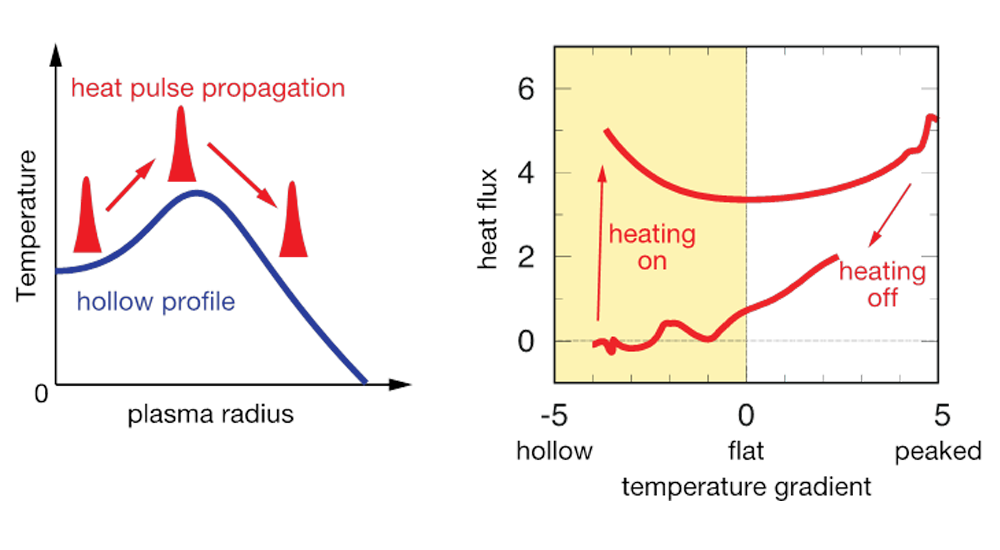Investigating plasma transport with a hollow temperature profile by heat pulse propagation
Heat transport in fusion plasmas is often modeled as a temperature gradient. In contrast, when a narrow region away from the plasma center is heated to create a plasma with a peculiar hollow temperature profile, and then a narrow region near the center is additionally heated, a transient phenomenon was observed in which the heat pulse propagates against the temperature gradient. Furthermore, by switching the heating on and off, it was experimentally evaluated that the driven heat flux is not determined by the temperature gradient alone.

To realize fusion power generation, it is necessary to generate high-temperature plasma. However, even if the heating power is the same, the temperature profile of the generated plasma will alter if the heating location is different. Therefore, it is essential to study the mechanism (confinement and transport) of how different temperature profiles are formed.
Heat transport is usually considered in a diffusion model, where heat flux is driven by a temperature gradient (heat flows from a higher temperature to a lower one). The Large Helical Device (LHD) has an external heating method called electron cyclotron heating (ECH) that can heat a narrow plasma region. Usually, the plasma center is heated to produce a high-temperature plasma, forming a peaked electron-temperature profile. However, in this study, we first observed that heating a location far from the plasma center can form a hollow electron-temperature profile. If a temperature gradient can only describe heat transport, heat will flow toward the center in a hollow profile. However, heating the location away from the center, the heat escapes outward, so there is no heat flowing toward the center. Outward heat flux is needed to cancel the inward heat flux, driven by the temperature gradient. In a steady state with an unchanging temperature profile, it appears possible to represent the non-diffusive outward heat flux by heat convection. Such a model could reproduce the electron temperature profile in LHD plasmas.
Next, we experimentally investigated how the plasma with a hollow electron-temperature profile would respond if additional ECH was applied to the center. In other words, the transient response of how the heat pulse propagates outward from the center was investigated from the time evolution of the electron temperature profile. We found that the heat pulse transiently propagated against the temperature gradient. In other words, net heat transiently flowed from a lower temperature to a higher one. Also, due to central heating, the electron temperature profile changed from a hollow profile to a peaked one over time, but there was a time when it just flattend out (the temperature gradient became zero). Even then, net heat flowed outward. By directly examining the relationship between the temperature gradient and the driven heat flux experimentally, we found that the diffusion model did not explain the heat transport in this case.
Subsequently, when the central heating was turned off, the relationship between the temperature gradient and the driven heat flux, as the temperature profile reverted from a peaked profile to a hollow one, was investigated. It was found that the trajectory was different from that when central heating was applied. This phenomenon is called transport hysteresis. We found that the transport at a certain location is not determined by the temperature gradient or temperature at that location. We observed that this hysteresis was repeated by turning the central heating on and off. The non-local nature of non-diffusive heat transport, associated with heat convection, was experimentally revealed as the electron temperature moved back and forth between the states of peaked, flat, and hollow profiles. This finding is a new insight into transport phenomena in fusion plasmas.
This research was conducted by a research group led by Toru Tsujimura and Tatsuya Kobayashi at the National Institute for Fusion Science.
The research result was published in Physics of Plasmas, a journal of the American Institute of Physics, on March 2, 2022.
